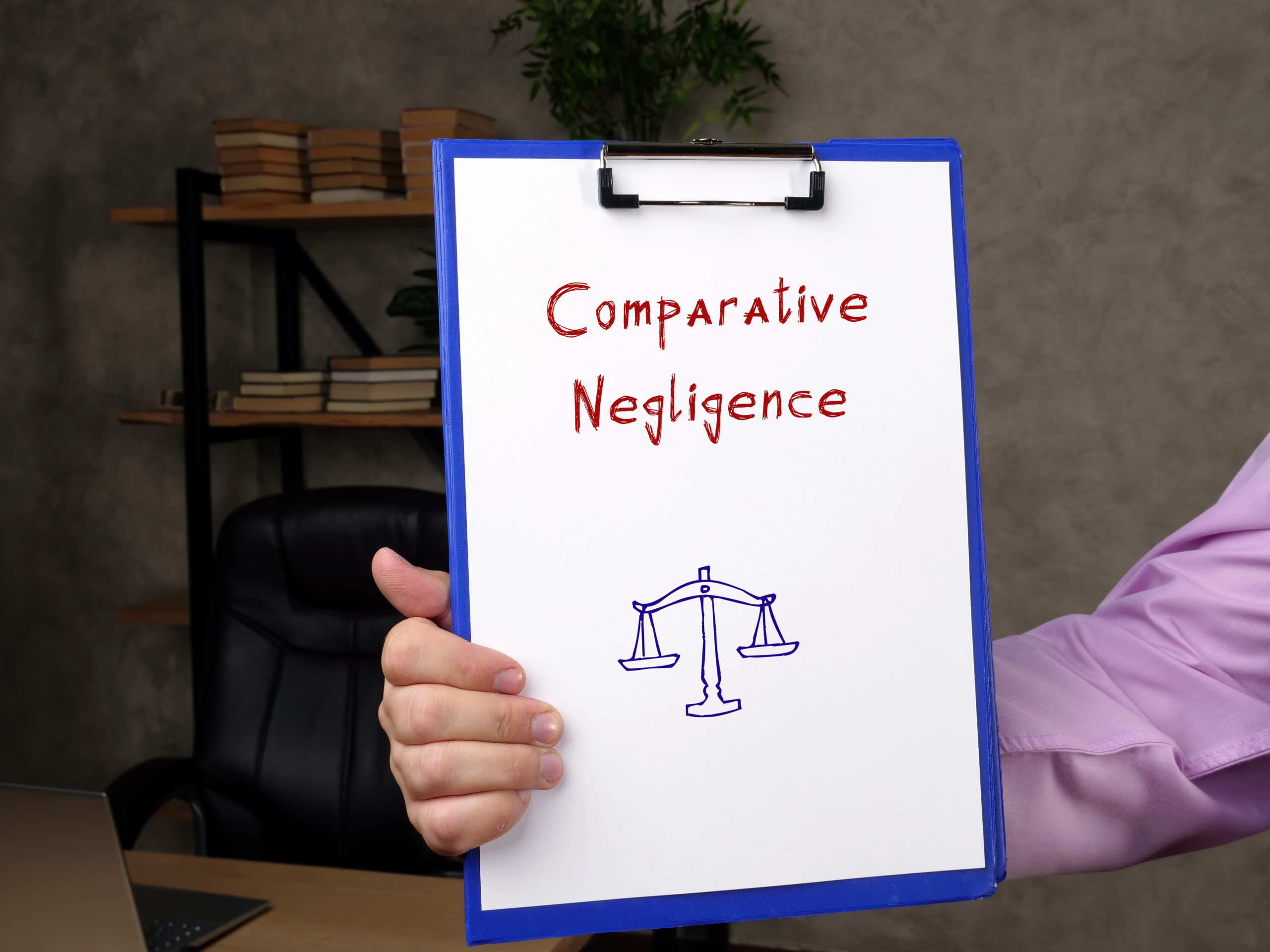 Every state has its own set of laws governing how much compensation a person can claim in a personal injury lawsuit, and a major aspect of these regulations involves “comparative negligence.” This refers to whether an injured person can recover damages if they’re partially at fault for the accident. While some states rule that an injured person is disqualified from filing a claim if they’re even one percent at fault, other states have more complex laws that allow them to sue another party for their injuries if they’re partially—or even mostly—at fault.
Every state has its own set of laws governing how much compensation a person can claim in a personal injury lawsuit, and a major aspect of these regulations involves “comparative negligence.” This refers to whether an injured person can recover damages if they’re partially at fault for the accident. While some states rule that an injured person is disqualified from filing a claim if they’re even one percent at fault, other states have more complex laws that allow them to sue another party for their injuries if they’re partially—or even mostly—at fault.
Pennsylvania comparative negligence laws allow individuals who have been injured in an accident to recover compensation for damages even when they are partly at fault. However, Pennsylvania regulations state that, depending on the plaintiff’s degree of shared fault, the damages they’re permitted to collect may be limited or, in some cases, completely restricted.
- Contributory Negligence in Personal Injury Lawsuits
- Comparative Negligence in Personal Injury Lawsuits
- Comparative Negligence Laws in Pennsylvania
- Determining Fault in Pennsylvania
- The Fair Share Act and Damages
- Pennsylvania as a Pure Comparative Negligence State
- Impact of Comparative Negligence on Your Case
- Contact an Experienced Personal Injury Lawyer in Montgomery County
Contributory Negligence in Personal Injury Lawsuits
Contributory negligence bars an injured person from any damage award if they contributed to the injuries at all. In this case, if the defendant can provide the smallest fraction of evidence that proves that you were even one percent at fault for your accident, your case may be in danger. As a result, contributory negligence primarily benefits insurers and defendants. Only four states follow this rule: Alabama, North Carolina, Maryland, and Virginia (including D.C.).
Comparative Negligence in Personal Injury Lawsuits
Comparative negligence laws, on the other hand, aim to compensate the plaintiff for at least partial damages according to their percentage of fault. Understanding these laws is crucial for anyone involved in a personal injury claim, as the degree of fault can significantly impact the financial recovery. Most states abide by comparative negligence. Within the legal concept of comparative negligence are two subcategories: pure comparative negligence and modified comparative negligence. In a pure comparative negligence state, a plaintiff can carry any percentage of fault—even 99 percent—and still be eligible for damages. About a third of U.S. states utilize this rule.
Modified comparative negligence imposes a certain limit on the plaintiff’s degree of fault, above which the plaintiff forfeits recovery. The majority of states follow the modified comparative fault model, which is split into two distinct categories: the 50 percent bar rule and the 51 percent bar rule. In states following the 50 percent rule, a party that is 50 percent or more responsible for an accident may not recover any damages. In states adhering to the 51 percent rule, a party may not recover any damages if they’re 51 percent at fault.
Pennsylvania is a modified comparative negligence state that follows the 51 percent modified comparative rule.
Comparative Negligence Laws in Pennsylvania
Pennsylvania’s comparative negligence laws, detailed in 42 Pa C.S.A. § 7102, provided that a plaintiff’s fault does not bar them from recovery so long as they’re less at fault than the defendant: Pennsylvania’s comparative negligence laws allow injured individuals to recover damages even if they share some fault in the incident, detailing how the degree of fault affects the potential compensation.
“In all actions brought to recover damages for negligence resulting in death or injury to person or property, the fact that the plaintiff may have been guilty of contributory negligence shall not bar a recovery by the plaintiff or his legal representative where such negligence was not greater than the causal negligence of the defendant or defendants against whom recovery is sought…”
In other words, so long as the accident victim is less than 51 percent to blame for the accident, they can still recover damages based on the percentage they’re at fault. For example, if you were only 20 percent at fault, you can still recover 80 percent of whatever amount is awarded as compensation. If you were 51 percent or more at fault, however, you lose the right to receive any compensation at all.
Determining Fault in Pennsylvania
Determining fault in Pennsylvania is a pivotal aspect of personal injury cases. Under Pennsylvania’s comparative negligence laws, the court or jury must assess the degree of fault for each party involved in the accident. This process involves a thorough examination of all available evidence, such as witness statements, police reports, and physical evidence from the scene. The court or jury then assigns a percentage of fault to each party, which directly influences the amount of damages that can be recovered.
In Pennsylvania, a plaintiff’s contributory negligence does not completely bar them from seeking compensation for their injuries. However, the amount of damages they can recover will be reduced in proportion to their percentage of fault. For instance, if a plaintiff is found to be 30% at fault for the accident, they can still recover 70% of the total damages awarded. This approach ensures that even if the injured party shares some responsibility for the accident, they can still receive compensation for their losses.
The Fair Share Act and Damages
The Fair Share Act in Pennsylvania plays a crucial role in determining how damages are allocated among multiple defendants in personal injury cases. According to this Act, each defendant is only liable for their specific share of fault. This means that if there are several defendants, each one will be responsible for paying damages corresponding to their percentage of fault. However, if a defendant is found to be 60% or more at fault, they can be held responsible for the entire amount of damages awarded.
The Fair Share Act was designed to ensure fairness by preventing defendants from being unfairly burdened with damages that exceed their level of fault. However, it can also impact the total amount of damages a plaintiff can recover. For example, if multiple defendants are each found to be 20% at fault, the plaintiff may only be able to recover 20% of the damages from each defendant. This underscores the importance of accurately determining each party’s fault to ensure fair compensation.
Pennsylvania as a Pure Comparative Negligence State
It’s important to clarify that Pennsylvania is not a pure comparative negligence state. Instead, it follows a modified comparative negligence rule. Under this rule, a plaintiff can recover damages even if they are partially at fault, as long as their fault does not exceed 50%. This is in contrast to pure comparative negligence states, where a plaintiff can recover damages regardless of their percentage of fault, even if they are 99% at fault.
Pennsylvania’s modified comparative negligence rule is more lenient than the contributory negligence rule, which completely bars a plaintiff from recovering any damages if they are even slightly at fault. In Pennsylvania, as long as the plaintiff can demonstrate that the defendant was more at fault, they can still recover compensation. This approach provides a more balanced and fair system for plaintiffs seeking to recover damages for their injuries.
Impact of Comparative Negligence on Your Case
The impact of comparative negligence on your personal injury case can be substantial. If you are found to be partially at fault for the accident, the damages you can recover will be reduced in proportion to your percentage of fault. For example, if you are determined to be 30% at fault, you will only be able to recover 70% of the total damages. This reduction can significantly affect the compensation you receive for medical bills, lost wages, and other expenses.
However, if you can prove that the defendant was more at fault, you may still be able to recover a significant portion of the damages. For instance, if the defendant is found to be 70% at fault, you can recover 70% of the total damages awarded. Understanding how comparative negligence works in Pennsylvania is crucial for maximizing your compensation.
Given the complexities of comparative negligence laws, it is essential to consult with a knowledgeable personal injury attorney. An experienced lawyer can help you navigate the legal process, gather necessary evidence, and build a strong case to ensure you receive the compensation you deserve. If you have been injured in an accident, don’t hesitate to seek legal advice to protect your rights and interests.
Contact an Experienced Personal Injury Lawyer in Montgomery County
If you were injured in an accident, the experienced Southeast Pennsylvania personal injury attorneys at Rubin, Glickman, Steinberg & Gifford P.C. may be able to help. Under Pennsylvania’s comparative negligence laws, identifying and establishing fault will largely determine the outcome of your case, so having an attorney represent you may be pivotal to your case’s success. After meeting with you one-on-one to discuss your case and any potential obstacles during a free consultation, we’ll outline the facts and circumstances surrounding any impending legal action in order to help you determine the most strategic method to compensate you for any damages.
For nearly 68 years, our attorneys have been serving the legal needs of clients in Montgomery County, Bucks County, Lehigh County, Chester County, Delaware County, and throughout the surrounding areas. We’ve earned the trust and respect of clients facing a wide range of legal problems. Our attorneys serve to protect you and guard your rights. Call (215) 822-7575 or complete our online contact form today.

Rubin, Glickman, Steinberg & Gifford P.C.
Pennsylvania Attorney's
March 1, 2025









